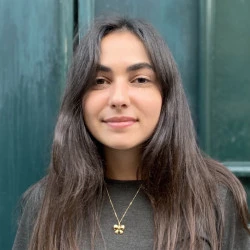What design for everyone truly means – Interview with Marie van Driessche
“Accessibility can be scary, but it’s very rewarding.” Visual and interaction designer Marie van Driessche is taking on the challenge and tapping into inclusive design by placing the user at the core of her process.

Marie van Driessche is a Deaf designer from Amsterdam focused on making digital platforms accessible to everyone.
She has a BA in Graphic Design from the Royal Academy of Art in The Hague and a Master in Graphic Moving Image from the University of Arts, London.
Marie is currently working at VPRO, a Dutch broadcasting company where she aims at implementing accessibility.
She has also been giving talks about UX and accessibility topics at a number of meetups, such as IXDA events, Interaction ’18 and AWWWARDS, and teaching UX / UI design at the University of Applied Sciences in Amsterdam.
DesignWanted recently published an article looking at a selection of products that have been designed to address the needs of deaf and hard of hearing people.
However, we recognize that some of these projects are only concepts tapping into the subject matter and that they can be perceived as a glimpse of design’s possibilities toward inclusivity.
We talked to Marie van Driessche to better understand the needs of Deaf people, her process, and her approach towards more accessible design.
Who is Marie van Driessche? How did your journey in design begin?
Marie van Driessche: “My name is Marie van Driessche, i’m 32 years old.
My childhood years revolve around drawing and handicrafts with both of my parents being artists.
There was always a table available for the children, full of pens, markers, paper, and glue.
I always wanted to do something creative.
After my high school diploma, I wanted to study photography, but I stumbled upon the Graphic Design department at the open house of Royal Academy of the Arts, at the Hauge, and fell in love with Graphic Design.
I immediately knew; this was what I was looking for, combining language and images to convey information.
During my BA studies, I found out that I wanted to continue exploring movement in Graphic Design, so I did a MA Graphic Moving Image at the University of Arts in London, UK.
After graduating from my studies, I moved to Toulouse, France, where I joined a company, Websourd, with a focus on the communication, motion graphics and translation of French to French Sign Language by 3D avatars, for different clients like France3 Television, SNCF and Orange.
I moved back to the Netherlands afterward, to work at eend.nl.
“Eend mainly focuses on the public sector, such as government websites. I became aware of the deficiency of necessary websites, like the websites of some municipalities. Why make processes complicated if they can be done easily and accessible?
This is when I realized that the web is not necessarily accessible to everyone. Thus, began my journey in accessibility and inclusive design.
Afterwards I worked in one of the biggest banks in the Netherlands, ABN AMRO.
Today, I work as an interaction designer / UX at a Dutch broadcasting company, VPRO.
I’m working on different projects and trying to implement accessibility at VPRO.
Besides working at VPRO, I have been a speaker on various occasions discussing UX/UI, accessibility topics and inclusive design at a number of Meetups, IXDA events, Interaction ’18 and AWWWARDS.
I also work as a teacher of UX / UI design at the University of Applied Sciences in Amsterdam.”

Research, design and development of the branding and an interactive website for ‘Gooi en Vecht Historisch’, the archives of Gooi & Vecht area, with Eend – Images courtesy of Marie van Driessche
As an interaction designer, why focus on the fields of accessibility, language, sign language, accessible design, usability?
Marie van Driessche: “I found out that the Internet is not accessible to so many people. In addition, there’s so much ignorance about Deaf people, about the language barriers they have.
So many people just assume because Deaf people can’t hear, they just add closed captions in their videos.
But there’s a large group of Deaf people who grew up with sign language.
Sign language is not pantomime or simple gestural codes based on spoken language.
Sign languages are visual-spatial languages, without a natural written form.
Grammar and syntax are very different from that of spoken languages and rely heavily on facial expression to convey essential meaning and emphasis.
Be aware that there’s no such thing as a Universal Sign Language.
Every country has its own sign language, like spoken languages, which means most deaf people learned English or their country language as a second language.
With subtitles / closed captions you provide written translation for people who don’t have a written form of their first language, which means that synonyms, word plays and language jokes are not always understood for Deaf people.
There are so many different kinds of Deaf people, there are deaf/hard of hearing people who feel confident with the primary language of their country.
There are also deaf people who rely on sign language, the spoken language of their country is their second language.
Even more, deaf people have additional disabilities, like learning difficulties.
Besides all of the above, my ultimate goal is that anyone can use the Web, even my hearing aunt of 68, low-literate deaf people and people who can’t hear or see very well.”

Interested in knowing more about inclusive designs? Check out how Simon Dogger is creating more inclusive forms of communication.
Can you tell us more about your work on the Design System and the renewal of VPRO.nl?
Marie van Driessche: “Unfortunately, too little time has been set aside for this, it is still in its very early stage.
We are working hard to find and develop the right tools and make sure that everything we deliver is accessible.”
Being prototyping a key moment within the design process, what do you learn from building a prototype?
Marie van Driessche: “The end-user of my product is the most important for me.
Can they use my product? It’s important to ask questions, to challenge your biases and assumptions.
You can do this by asking, by interacting with your fellow human beings, preferably with people who don’t look like you.
Ask questions like: “Am I just confirming my assumptions, or am I challenging them?” “What are my biases?” “Who might be impacted by what I’m designing?” “How will they use it?“
Test as early as possible.
By testing your prototype you’ll be confronted by your biases.
Test with people who are different from you.
We, designers, strive for solutions that work well, solve needs, improve lives. But the problem is if we use our skills as a baseline, that will be good for someone but not everyone.
Learn from people who’ve experienced great degrees of exclusion in their lives. Your user is the expert, not you.”
While designing a digital product, what considerations should be taken into account by a designer in terms of accessibility? And what about inclusivity?
Marie van Driessche: “Accessibility can be scary, but it’s very rewarding. It’s important for everyone. Everyone will get a disability at one point in their lives. You’ll need glasses one day, or break your arm.
But I would like to emphasize that accessibility is not only about semantic HTML, enough contrast, but about inclusive language as well.
Be aware of how and what you’re addressing.
Inclusive design can be aesthetically beautiful and accessible at the same time.”
From an inclusive design perspective, what makes a design idea truly innovative?
Marie van Driessche: “I believe in innovation, there are many solutions and creativity, but it’s very important to create them with people.
I’ve seen so many examples of ‘innovative’ designs and products designed for Deaf People, such as the ones DesignWanted tap into in this article, but it’s clear that none of them are designed with a deaf person. We don’t need sign language gloves, we don’t need hairpins that vibrate.
Listen to the people carefully, ask them what they need, and sit around the table with them. That will make your product innovative.”
Curious to know more about designs catered to specific needs? We have rounded up 10 of the best autism-friendly design projects.

The design and production of an interactive online overview of all kinds of numbers related to the energy supply and the energy transition in the Netherlands, for Energie Beheer Nederland with eend.nl – Images courtesy of Marie van Driessche
What is the next step for Marie van Driessche?
Marie van Driessche: “I would like to continue with teaching at the University, because I firmly believe diversity and representation matter.
For the students, having a Deaf teacher should be normal, it should be the standard.
Besides I would like to be a certified accessibility specialist, make more people aware of accessibility, inclusive design, and make the web truly inclusive.
Teach people that they can create beautifully designed solutions that are accessible and inclusive by giving more talks, and I’m busy developing an Inclusive Design workshop from a deaf perspective.
I also hope to grow more in a leadership role, managing teams and projects. I’ve been playing with the idea to start a blog/vlog to share my experience and knowledge as a Deaf designer and develop a new talk.
And most importantly, make VPRO fully accessible, and other broadcasting companies as well.”









